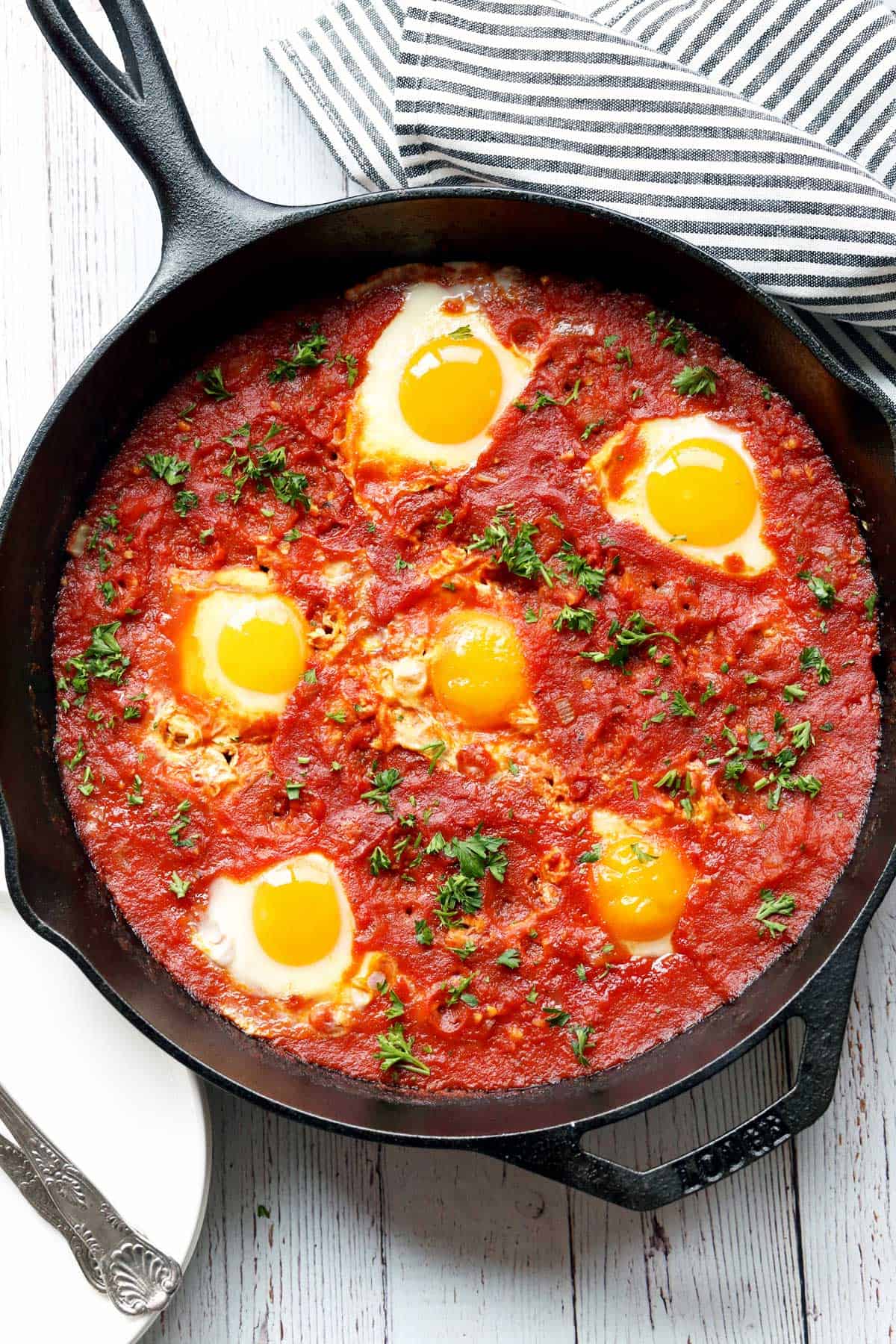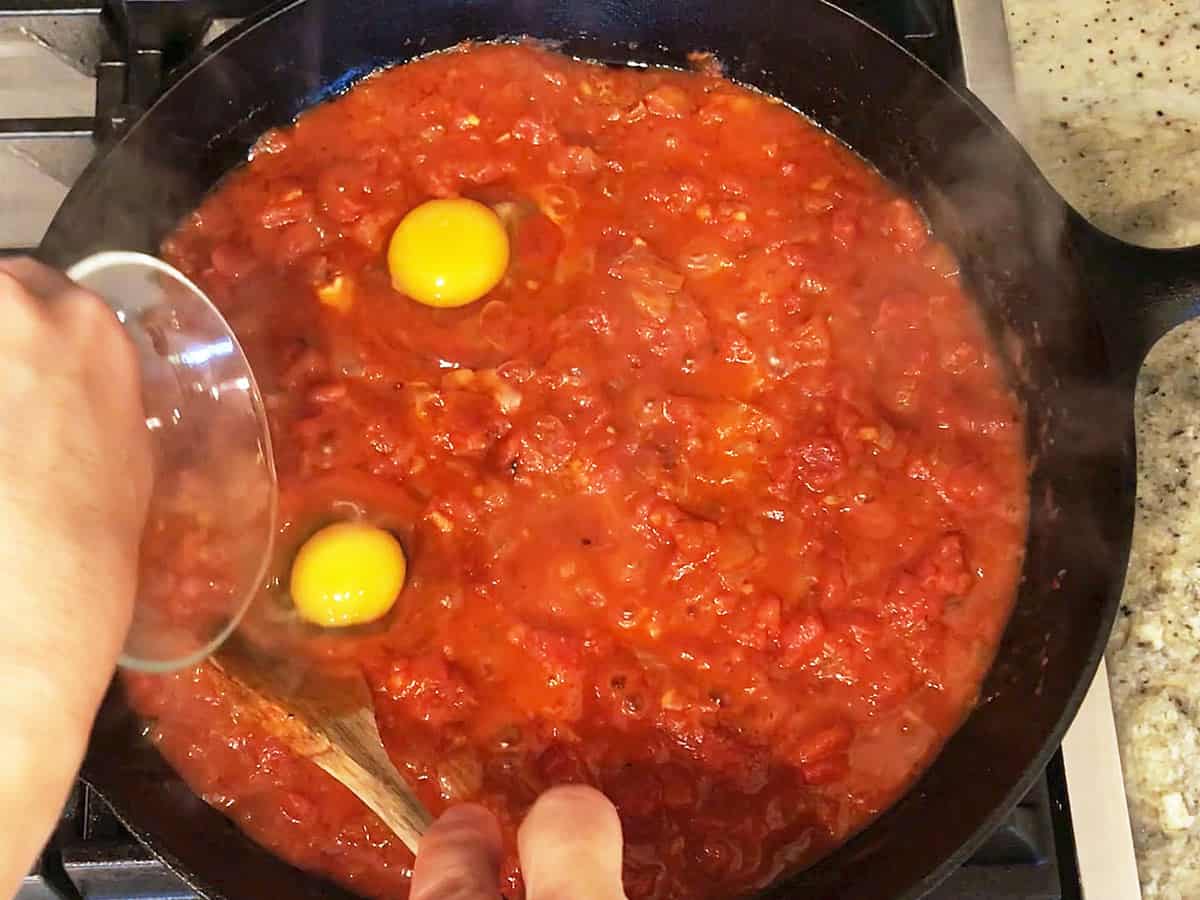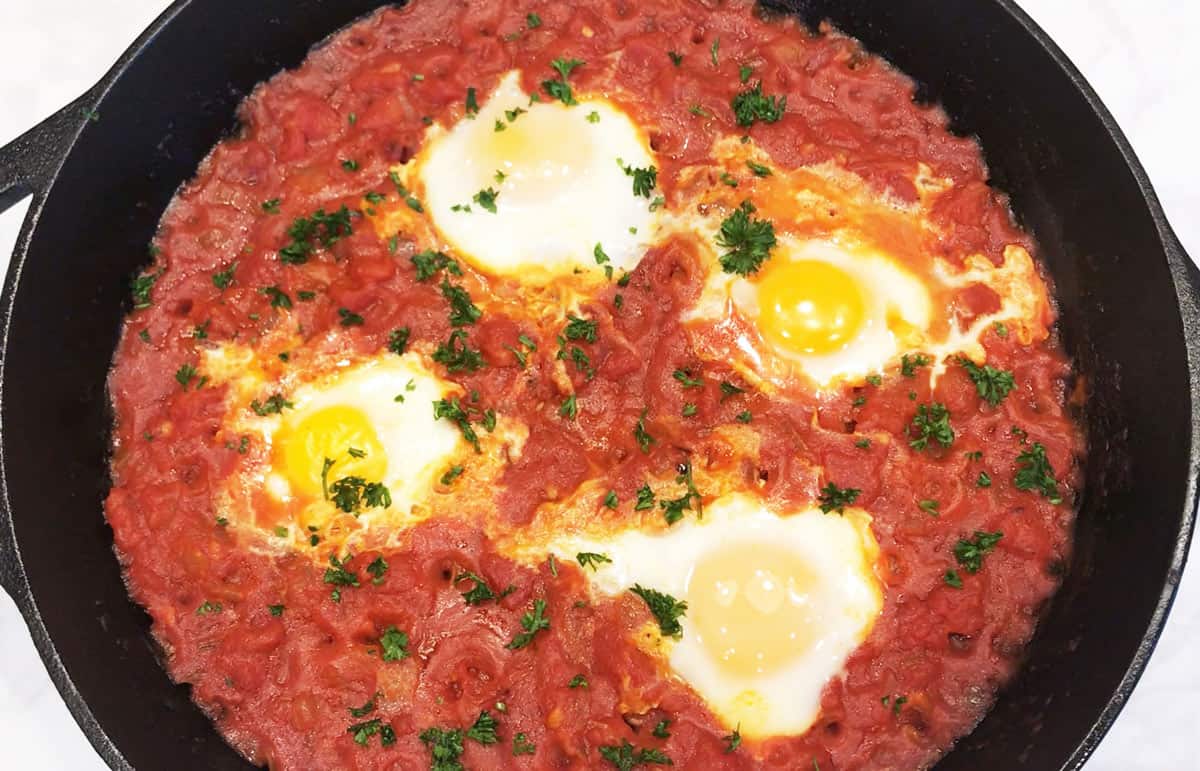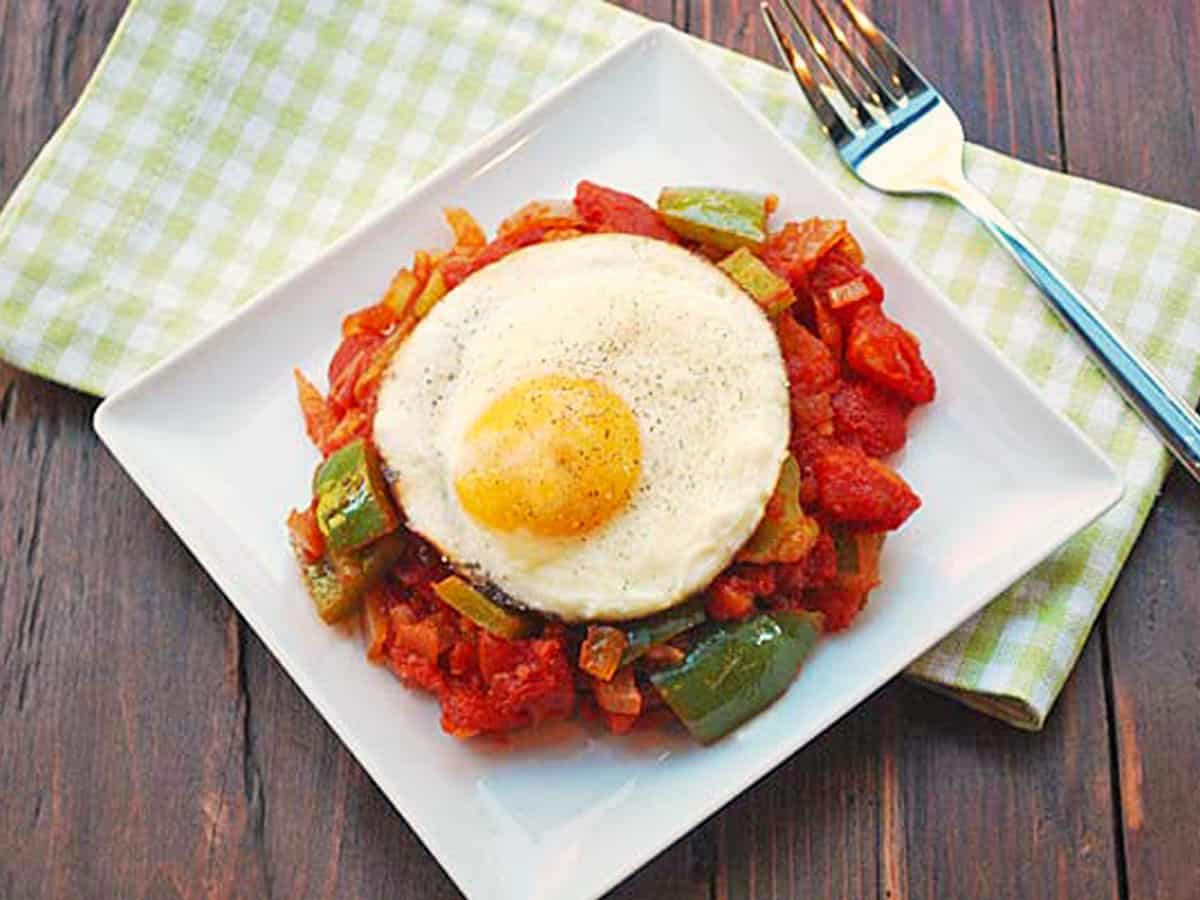Shakshuka, a flavorful dish of eggs poached in a spicy tomato sauce, is surprisingly easy to make and can be served for breakfast or dinner.

I often serve my family lighter, egg-based dinners, especially in the summer. One such dinner is avocado egg bake, and I also like to make this shakshuka recipe. This quick skillet dinner is ready in 30 minutes, is flavorful and filling, and my entire family enjoys it. And while it practically begs for crusty bread for dipping, you could easily enjoy it with thick slices of homemade almond flour bread.
Ingredients

See the recipe card for exact measurements. Here are my comments on some of the ingredients.
- Olive oil: Extra-virgin olive oil is best.
- Aromatics: Chopped onion and minced garlic.
- Tomatoes: The stars of the show! You could use fresh tomatoes, but I usually use canned petite-diced tomatoes or Pomi chopped tomatoes. Pomi is an excellent Italian brand. Its tomatoes are sweeter and less acidic than American ones, and they are chopped very finely, which is perfect in this recipe.
- Spices: Paprika, cumin, and red pepper flakes.
- Eggs: I use large eggs in most of my recipes. But in this recipe, medium or even small eggs are better because it's easier for the tomato sauce to contain a smaller volume of egg whites.
Variations
- I love adding a generous pinch of smoked paprika for an interesting smoky flavor. Sometimes, I use ¼ teaspoon of cayenne pepper instead of red pepper flakes. Dried thyme and oregano are also delicious. You can add ½ teaspoon of each.
- You can use different cooking fats instead of olive oil. Butter or ghee are good options.
- Many shakshuka recipes add bell peppers in addition to tomatoes. I usually don't. But if you'd like, you can add 1-2 finely chopped bell peppers and cook them with the onions.
- Sometimes, I use small skillets to make individual servings, as shown in the photo below.

Instructions
The detailed instructions and step-by-step photos are included in the recipe card. Here's a quick overview.
Cook the onion in olive oil with salt. Add the garlic, paprika, cumin, and red pepper flakes.

Add the tomatoes and cook for about 10 minutes. Add the eggs and cook them for 5-10 minutes, or until set.

Sprinkle the shakshuka with salt, pepper, and parsley, then serve.

Recipe Tips
- As mentioned above, it's best to use medium eggs. If you use large eggs, the volume of egg whites will be too high for the tomato sauce to contain. If you only have large eggs, crack each egg into a small bowl and pour out some of the egg white before adding the eggs to the skillet.
- At the very last step, after you add the eggs to poach in the tomato sauce, it's tempting to cover the skillet so that the egg whites can cook faster. However, this will cause a milky film to form on the egg yolks, as shown in the photo below. So it's best to patiently cook the eggs uncovered. If it seems like the tomato sauce is drying while the eggs cook, lower the heat to medium-low or even low. You can also drizzle a bit of water on the tomato sauce.

Serving Suggestions
Outside of Israel, shakshuka is usually considered breakfast food. But in Israel, it is often served for dinner. Israelis tend to eat their main meal for lunch and have a lighter meatless dinner. As a child, my mom usually served us an omelet and an Israeli salad for dinner.
While the spicy tomato sauce and runny egg yolks practically beg for crusty bread, bread is not mandatory! A fork and a knife (plus a spoon) are just as efficient when enjoying shakshuka. Sometimes, however, my family enjoys this dish with thick slices of almond flour bread or these cheese biscuits. You can even use pork rinds for scooping out the tomato sauce.
Storing and Using the Leftovers
You can keep the tomato sauce but not the eggs. So, you can make as much of the sauce as you wish, keep it in a sealed container in the fridge for up to 4 days, and reheat it covered in the microwave, but only poach as many eggs as you'll eat right away.
When you serve the leftovers, fry or poach the eggs separately. Here's a plate with leftover shakshuka topped with a freshly fried egg:

Recipe Card
Easy 30-Minute Shakshuka Recipe
Video
Ingredients
- 2 tablespoons olive oil - extra-virgin
- 1 medium onion - chopped; 6 ounces
- 1 teaspoon Diamond Crystal kosher salt - divided, plus a pinch for the eggs; see notes below
- 1 tablespoon garlic - minced
- 1 teaspoon paprika
- ½ teaspoon cumin - ground
- ½ teaspoon red pepper flakes - ¼ teaspoon you don’t like spicy food
- 28 ounces petite-diced tomatoes - undrained; or 26 ounces of Pomi chopped tomatoes
- ¼ teaspoon black pepper - plus a pinch for the eggs
- 6 medium eggs
- 2 tablespoons cilantro - for garnish, chopped
Instructions
- Heat the oil in a large, heavy saucepan over medium-high heat. I like to use a well-seasoned cast-iron skillet.
- Add the onions and ½ teaspoon of kosher salt and cook, stirring often, until golden, about 5 minutes.
- Reduce the heat to medium. Add the garlic, paprika, cumin, and red pepper flakes and cook, stirring, for 30 seconds.
- Add the tomatoes (undrained), the remaining ½ teaspoon of kosher salt, and black pepper. Cook for 10 more minutes, uncovered, stirring frequently, so the sauce thickens and the flavors meld.
- Crack the eggs into small bowls. With the back of a spoon, make a well in the sauce and carefully pour an egg into it. Gently push the tomato sauce over the edges of the egg white to keep it from spreading too much. Repeat with three more eggs, spacing them apart so that the eggs are more or less evenly distributed.
- Reduce the heat to medium-low and keep cooking the shakshuka, uncovered and undisturbed, until the egg whites are set but the yolks are still soft, 5-10 more minutes. It’s best not to cover the skillet, as this creates a milky white film on the egg yolks.
- Sprinkle the eggs with salt and pepper to taste, garnish with chopped cilantro or parsley, and serve.
Notes
- If using any salt other than Diamond Crystal Kosher Salt, including Morton kosher salt, use half the amount listed.
- It's best to use medium eggs. If you use large eggs, the volume of egg whites will be too high for the tomato sauce to contain. If you only have large eggs, crack each egg into a small bowl and pour out some of the egg white before adding the eggs to the skillet.
- At the very last step, after you add the eggs to have them poached in the tomato sauce, it's tempting to cover the skillet so that the egg whites can cook faster. However, covering the skillet will result in a milky film forming on the egg yolks. It's still tasty but not as pretty. So, it's best to patiently cook the eggs uncovered. If it seems like the tomato sauce is drying while the eggs cook, lower the heat to medium-low or even low. You can also drizzle a bit of water on the tomato sauce.
- You can keep the tomato sauce but not the eggs. So, you can make as much of the sauce as you wish and keep it in a sealed container in the fridge for up to 4 days, but only poach as many eggs as you'll eat right away. Then, when you serve the leftovers, you can fry or poach the eggs separately.
Nutrition per Serving
Save this Recipe!
We will also add you to our weekly newsletter. Unsubscribe anytime. See healthyrecipesblogs.com/privacy/ to learn how we use your email.
Disclaimers
Most recipes are low-carb and gluten-free, but some are not. Recommended and linked products are not guaranteed to be gluten-free. Nutrition info is approximate. Please verify it independently. The carb count excludes non-nutritive sweeteners. Please read these Terms of Use before using any of my recipes.












